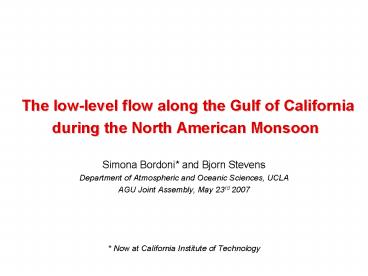Simona Bordoni and Bjorn Stevens - PowerPoint PPT Presentation
1 / 11
Title:
Simona Bordoni and Bjorn Stevens
Description:
The low-level flow along the Gulf of California during the North American Monsoon ... them as the leading mode of summertime variability in the low-level flow. ... – PowerPoint PPT presentation
Number of Views:46
Avg rating:3.0/5.0
Title: Simona Bordoni and Bjorn Stevens
1
The low-level flow along the Gulf of California
during the North American Monsoon
- Simona Bordoni and Bjorn Stevens
- Department of Atmospheric and Oceanic Sciences,
UCLA - AGU Joint Assembly, May 23rd 2007
- Now at California Institute of Technology
2
Satellite-derived data
- QuikSCAT winds
- available from 1999 to present
- accuracy of 2 m s-1 in speed and 20o in
direction - spatial resolution .25o
- GPCP 1DD precipitation dataset
- blended global precipitation product on 1o grid
Reanalyses
- NCEP
- available till present
- global dataset on a 2.5o grid
- ERA-40
- available till August 2002
- global dataset on a 1.1o grid
3
The mean low-level winds
4
Time series of the low-level winds
5
Gulf Surges in QuikSCAT data
6
Principal Component Analysis of the GoC winds
Leading EOF Gulf surge mode
Leading PC Gulf surge index
7
Lagged regression of QSCAT winds on leading PC
8
Does the leading EOF represent a gulf surge mode?
9
Lagged regression of precipitation on the surge
index
10
How do transients modulate precip?
Surge contribution to total precip ()
Mean daily rain rates
11
Summary
- Analysis of low-level winds over the NAM region
shows that the onset of the summer season is
accompanied by a seasonal reversal of the low
level flow along the GoC. - In the heart of the monsoon, the southerly flow
is found to be composed of distinct transient
events, gulf surges. An EOF analysis of the winds
identifies them as the leading mode of summertime
variability in the low-level flow. - These transient events strongly modulate the
monsoonal precipitation, especially in the
marginal monsoon regions. - Although seemingly mesoscale features, they are
intimately connected to processes controlling the
variability of the eastern Pacific ITCZ (please
see our paper, Bordoni and Stevens 2006).































